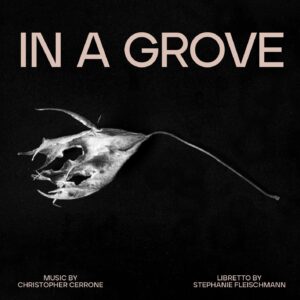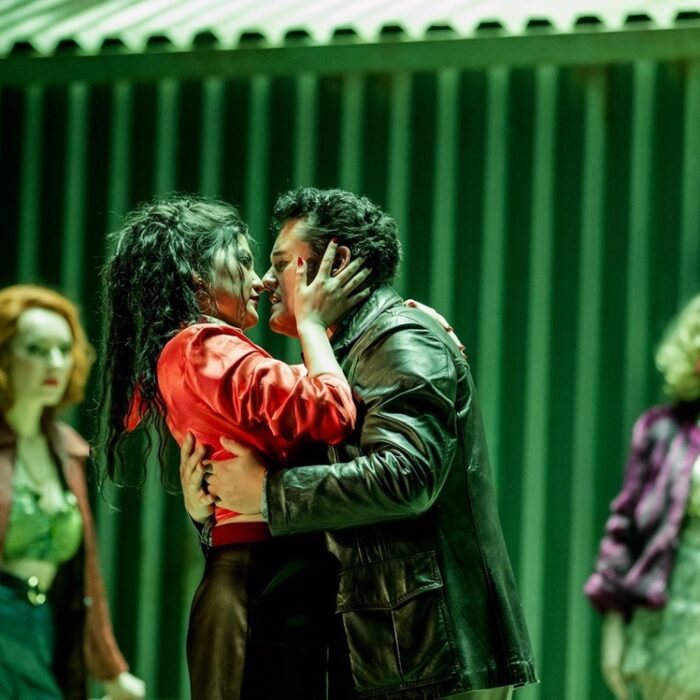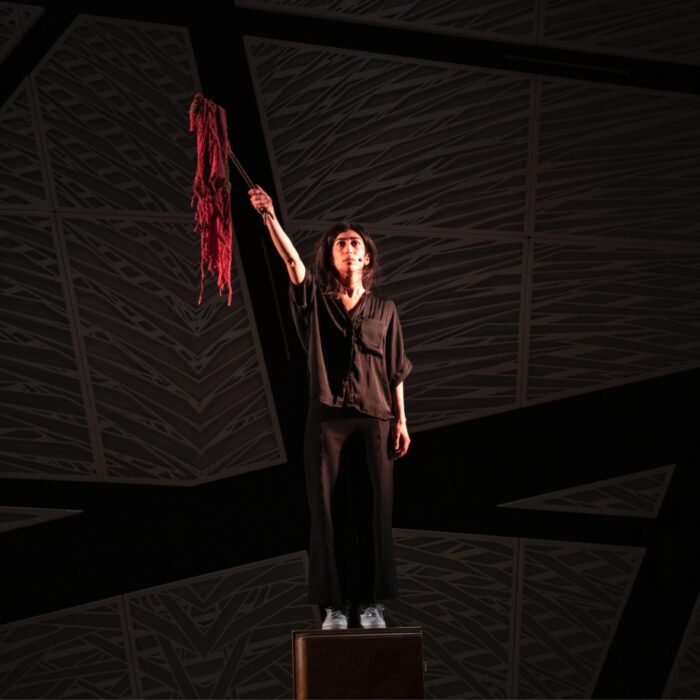
CD Review: Christopher Cerrone’s ‘In a Grove’
By Bob DieschburgA meditation on trauma and the fallacies of human memory, “In a Grove” is Christopher Cerrone and librettist Stephanie Fleischmann’s take on a 1922 short story by Japanese author Ryonūsuke Akutagawa.
With its limited cast of four soloists (doubling as two characters each) it centers on the murder of Ambrose Raines which Cerrone recounts in four testimonies and three confessions. Accordingly, the opera is divided into two parts with interludes set to orchestrally comment on the narrative and its “blur[ring] the edges of remembering” – to quote the character of Luther Harlow in Scene five.
The result is a harrowing dive into the human psyche, minimalist, in terms of the music, and experimental at the same time. “In a Grove” is written for a small orchestra of only nine instrumentalists (incl. a piano) focusing on a lean blend between their sounds and electronics. The latter also enhance the singing in an attempt to recreate Akutagawa’s concept of the unreliable narrator, using distortion and granulation seemingly at will.
From Japan to the Pacific Northwest
“In a Grove” assumes a very existentialist stance, in the vein of Sartre, Camus, or even Beckett and is not confined to the Japanese milieu in which Akutagawa’s short story is originally set. Rather, it is meant to be understood within the culturally familiar space of the Pacific Northwest that resonates with American audiences (to paraphrase a 2022 interview with both Fleischmann and Cerrone).
As such, it revels in a dreamlike soundscape in which the overall anguish of its protagonists appears condensed in musical symbols. The final scene, “The Murdered Man, Channeled by a Medium,” with its slow pace and the low tessitura parts of Leona and the Medium illustrate this best, as the pizzicato of the strings seems to reflect both the process of ritualistically conjuring Ambrose Raines and the latter’s faint beating of the heart,“My heart’s atrophy.”
“A Sonic Drama”
The musical language of “In a Grove” is a very visual or psychographic one that does not easily make itself available to casual listeners.
It is therefore no secret that it unfolds its true impact only in live performances such as the 2022 run from Pittsburgh (available on YouTube). There, a crepuscular set design and staging translated the score’s musical ciphers into some sort of post-modern Gesamtkunstwerk earning Cerrone acclaim in newspapers nationwide.
However, the release from Johnny Gandelsman’s “In a Circle Records” does not pretend to be a 1:1 recreation of the world premiere in Pittsburgh in 2022 (“In a Grove” has since been staged at Northwestern University).
Rather, Gandelsman in his press release states the intention of creating “a sonic drama (…) utilizing over-dubbing, multi-tracking, close-miking, compression, and other studio techniques.”
Consequently, “In a Grove” represents a technical feat that blurs the boundaries of traditional opera and, as such, tends to sound a little too artificial for my own taste.
Take Leona’s aria “Smoke, ash, smoldering” whose haunting melody conveys all the anxiety of the “Missing Woman” (as Scene six is titled). Yet I am not sure the granulation to the vocal line of, in this case, Lindsay Kesselman is needed or even conducive to the effect Cerrone pursues, at least as far as the CD release is concerned. I do believe that electronic processing is at its most efficient in conjunction with the visual elements of a stage performance.
For Amateurs of Contemporary Opera
Two of the soloists from its Pittsburgh run also feature in the new release of “In a Grove.” Andrew Turner as Ambrose Raines and the Policeman as well as Chuanyuan Liu, in the roles of the Priest and the Medium. The latter’s wonderfully clear and, in the final scene, ethereal countertenor makes for a mesmerizing debut on CD.
It seamlessly matches the warm timbre of Andrew James. The Tacoma-born tenor has a Mozartian voice, malleable and sensitive to the frailty of his character. Young and undoubtedly gifted, he is one I would love to hear more of in future seasons as much as on record.
In the double role of the Woodcutter and Luther Harlow (the Outlaw) the recording relies on the sophistication of bass-baritone John Taylor Ward. Acclaimed for his stylistic nuance, Ward may be less of a ruffian than his counterpart in the Pittsburgh premiere. His portrayal overall, however, reveals a remarkably layered interpretation in line with the complexity of Akutagawa’s protagonists.
Finally, Lindsay Kesselman is immaculate as both Leona and the Mother. There is an innate clarity to her voice which not only accords well with the modernism of the score but also stands out in the ensembles. Like her fellow soloists she benefits from the meticulous playing of the New York-based Metropolis Ensemble in which Cerrone himself takes on the electronics.
This certainly imbues “In a Grove” with a sense of fidelity to its creator’s vision that subsequent performances (or recordings, for that matter) may not have. On a musical level, it therefore makes a strong case for the current release, for amateurs of contemporary opera and beyond.


